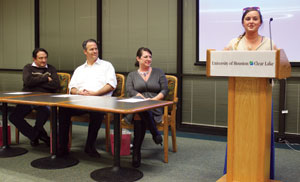
UHCL and USA think pink for collaborative video
Jessica Casarez
The Signal
During October, designated as Breast Cancer Awareness Month, organizations are encouraged to go out of their way to think of creative and unique ways to raise awareness.
One method that has gained popularity is the “Pink Glove Dance,” which originated at a hospital in Oregon and showcases people dancing while wearing pink gloves. Many of these dances, filmed and posted on YouTube, have become a source of inspiration and comfort for breast cancer survivors.
Digital Media Studies students from UHCL did not hesitate to partner with the United Space Alliance when asked to participate in creating a video for breast cancer awareness last month. The resulting video features employees of USA doing the “Pink Glove Dance.”
![think_pink Digital Media Studies graduate student Sophia Stewart shares her experience working with USA to develop the Pink Glove Dance video.]()
- Digital Media Studies graduate student Sophia Stewart shares her experience working with USA to develop the Pink Glove Dance video. Other panel members were (from left) Jim Hansen, videographer for NASA/Johnson Space Center and USA, Mike Uguccioni, FOX Sports producer and Kim Nahas, customer and community relations specialist for USA. Photo by Ashley Smith: The Signal.
USA decided to create the video after having several employees diagnosed with breast cancer in 2011. Kari Fluegel, senior manager of communication and public relations at United Space Alliance, decided to spearhead this project after being diagnosed herself earlier this year.
“This group of survivors recently banded together and decided they wanted to do something to help raise awareness of breast cancer issues within the aerospace community,” Fluegel said. “So, we decided to do our own USA ‘Pink Glove Dance’ with a space twist on it.”
USA and UHCL collaborated earlier when USA sponsored the UHCL digital media lab. A USA representative contacted Debra Clark, associate professor of communication and DMST, to see if she knew any students or individuals who would be interested in collaborating to make the video. Clark passed the message on to her graduate students and was pleased when three of them expressed interest.
Because she knew it was a great deal of work that needed to turn around quickly, Clark offered the students extra credit for their time and effort on the project.
“We collected over 67 hours of footage in less than a week,” Clark said. “We worked from 7:30 a.m. to 7 p.m. for three or four days and devoted two full days to editing.”
DMST students Sophia Stewart, Erik Sanchez and Manning Stinson agreed to take the project on as part of their Critical Approaches class.
Unlike many of her other projects for school, Stewart said she was faced with the hard reality of the “real world” as she discovered the difficulty of having multiple directors on one project.
“It was really difficult working with so many people and under so many different regulations,” Stewart said. “To please everyone was just impossible, but I agreed to do it, and afterwards I was really glad I did.”
Kimberly Nahas, USA customer and community relations specialist, was very involved with the structure of making the video. She was surprised at how many people ended up being involved with the project.
“Every senior member of leadership was involved,” Nahas said. “It started with 20 people and ended up with more than 100 people being involved.”
In order to maximize the space twist on the video, certain permissions had to be granted to be able to film inside some Johnson Space Center facilities, Space Center Houston and JSC facilities. Strict regulations had to be adhered to by everyone, including the students, while on those premises. Stewart was surprised when she was told she had to wear something over a tank top she had on while filming.
Although the video was made in a few days, a large amount of work went into it. USA contacted the hospital in Oregon who did the first “Pink Glove Dance” and also requested permission from the copyright owner of the song used in the video.
Upon completion of the video, both the students and USA employees felt a new kind of gratification and appreciation for the survivors of breast cancer.
“I have never been on the backside of making one of these videos before,” Stewart said. “It was very inspirational.”
Some employees with USA had not revealed they were breast cancer survivors until after this project was in the works.
“Survivors have this sisterhood,” Nahas said. “It’s something I have never witnessed. Nobody knows or understands that the way they do. To see the support they provide one another is astounding – it has more impact than any medicine.”
The USA Pink Glove Dance video is being shared on YouTube, Facebook, Twitter and on the company’s website. The ultimate goal is to raise as much awareness for breast cancer as possible.

